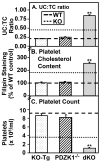Thrombocytopenia and platelet abnormalities in high-density lipoprotein receptor-deficient mice
- PMID: 18436807
- PMCID: PMC2683374
- DOI: 10.1161/ATVBAHA.108.162347
Thrombocytopenia and platelet abnormalities in high-density lipoprotein receptor-deficient mice
Abstract
Objective: High-density lipoprotein (HDL) receptor, scavenger receptor class B, type I (SR-BI), mediated cellular uptake of lipoprotein cholesterol controls HDL structure and plasma HDL and biliary cholesterol levels. In SR-BI knockout (KO) mice, an unusually high plasma unesterified-to-total cholesterol ratio (UC:TC) and abnormally large HDL particles apparently contribute to pathology, including female infertility, susceptibility to atherosclerosis and coronary heart disease, and anemia. Here we examined the influence of SR-BI deficiency on platelets.
Methods and results: The high plasma UC:TC ratio in SR-BI KO mice was correlated with platelet abnormalities, including high cholesterol content, abnormal morphologies, high clearance rates, and thrombocytopenia. One day after platelets from wild-type mice were infused into SR-BI KO mice, they exhibited abnormally high cholesterol content and clearance rates similar to those of endogenous platelets. Platelets from SR-BI KO mice exhibited in vitro a blunted aggregation response to the agonist ADP but a normal response to PAR4.
Conclusions: In SR-BI KO mice abnormal circulating lipoproteins, particularly their high UC:TC ratio-rather than the absence of SR-BI in platelets themselves-induce defects in platelet structure and clearance, together with a mild defect in function.
Conflict of interest statement
Figures






Similar articles
-
Restoration of high-density lipoprotein levels by cholesteryl ester transfer protein expression in scavenger receptor class B type I (SR-BI) knockout mice does not normalize pathologies associated with SR-BI deficiency.Arterioscler Thromb Vasc Biol. 2010 Jul;30(7):1439-45. doi: 10.1161/ATVBAHA.110.205153. Epub 2010 Apr 29. Arterioscler Thromb Vasc Biol. 2010. PMID: 20431066
-
Effects of hepatic expression of the high-density lipoprotein receptor SR-BI on lipoprotein metabolism and female fertility.Endocrinology. 2006 Apr;147(4):1577-88. doi: 10.1210/en.2005-1286. Epub 2006 Jan 12. Endocrinology. 2006. PMID: 16410302
-
Hypercholesterolemia impairs megakaryopoiesis and platelet production in scavenger receptor BI knockout mice.Atherosclerosis. 2019 Mar;282:176-182. doi: 10.1016/j.atherosclerosis.2018.09.019. Epub 2018 Sep 22. Atherosclerosis. 2019. PMID: 30278990
-
HDL scavenger receptor class B type I and platelet function.Curr Opin Lipidol. 2011 Aug;22(4):277-82. doi: 10.1097/MOL.0b013e32834701de. Curr Opin Lipidol. 2011. PMID: 21537173 Review.
-
Influence of the HDL receptor SR-BI on lipoprotein metabolism and atherosclerosis.Arterioscler Thromb Vasc Biol. 2003 Oct 1;23(10):1732-8. doi: 10.1161/01.ATV.0000091363.28501.84. Epub 2003 Aug 14. Arterioscler Thromb Vasc Biol. 2003. PMID: 12920050 Review.
Cited by
-
SR-BI (Scavenger Receptor Class B Type 1) Is Critical in Maintaining Normal T-Cell Development and Enhancing Thymic Regeneration.Arterioscler Thromb Vasc Biol. 2018 Nov;38(11):2706-2717. doi: 10.1161/ATVBAHA.118.311728. Arterioscler Thromb Vasc Biol. 2018. PMID: 30354229 Free PMC article.
-
Scavenger receptor BI modulates platelet reactivity and thrombosis in dyslipidemia.Blood. 2010 Sep 16;116(11):1932-41. doi: 10.1182/blood-2010-02-268508. Epub 2010 May 27. Blood. 2010. PMID: 20508162 Free PMC article.
-
HDL and Scavenger Receptor Class B Type I (SRBI).Adv Exp Med Biol. 2022;1377:79-93. doi: 10.1007/978-981-19-1592-5_6. Adv Exp Med Biol. 2022. PMID: 35575922 Review.
-
Proteomic diversity of high density lipoproteins: our emerging understanding of its importance in lipid transport and beyond.J Lipid Res. 2013 Oct;54(10):2575-85. doi: 10.1194/jlr.R035725. Epub 2013 Feb 24. J Lipid Res. 2013. PMID: 23434634 Free PMC article. Review.
-
Regulation of platelet function by class B scavenger receptors in hyperlipidemia.Arterioscler Thromb Vasc Biol. 2010 Dec;30(12):2350-6. doi: 10.1161/ATVBAHA.110.207498. Epub 2010 Nov 11. Arterioscler Thromb Vasc Biol. 2010. PMID: 21071700 Free PMC article. Review.
References
-
- Acton S, Rigotti A, Landschulz KT, Xu S, Hobbs HH, Krieger M. Identification of scavenger receptor SR-BI as a high density lipoprotein receptor. Science. 1996;271:518–520. - PubMed
-
- Rigotti A, Miettinen HE, Krieger M. The role of the high-density lipoprotein receptor SR-BI in the lipid metabolism of endocrine and other tissues. Endocr Rev. 2003;24:357–387. - PubMed
-
- Zannis VI, Chroni A, Krieger M. Role of apoA-I, ABCA1, LCAT, and SR-BI in the biogenesis of HDL. J Mol Med. 2006;84:276–294. - PubMed
-
- Kocher O, Yesilaltay A, Cirovic C, Pal R, Rigotti A, Krieger M. Targeted disruption of the PDZK1 gene in mice causes tissue-specific depletion of the high density lipoprotein receptor scavenger receptor class B type I and altered lipoprotein metabolism. J Biol Chem. 2003;278:52820–52825. - PubMed
Publication types
MeSH terms
Substances
Grants and funding
LinkOut - more resources
Full Text Sources
Other Literature Sources
Molecular Biology Databases
Research Materials

